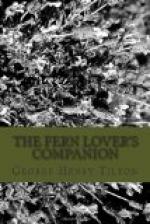[Illustration: Fragrant Fern. Aspidium fragrans (Mt. Mansfield. Vt.)]
KEY TO THE WOOD FERNS
ASPIDIUM
Fronds pinnate, the pinnae pinnatifid;
Blade soft and thin, not evergreen;
Lower
pinnae reduced to mere lobes
New
York Fern
Lower
pinnae but slightly reduced;
Veins
simple......................Massachusetts Fern
Veins
forked..............................Marsh Fern
Blade rather thick (subcoreaceous)
mostly evergreen;
Fronds small, narrow, glandular, rock species
Fragrant
Fern
Fronds large, two or more feet high;
Lower pinnae short, broadly triangular
Crested
Shield Fern
Lower pinnae longer;
Sori close to the margin....
Marginal Shield Fern
Sori nearer the midvein;
Frond lanceolate....................Male
Fern
Frond ovate..............Goldie’s
Shield Fern
Fronds twice pinnate with the lower pinnules pinnatifid
Boott’s
Shield Fern
Fronds nearly thrice pinnate................Spinulose Shield Fern
[Illustration: Marginal Shield Fern. Aspidium marginale]
THE WOOD FERNS
The ferns of this group, not counting the small fragrant fern, prefer the woods or at least shady places. Although the genus Polystichum represents the true shield ferns, the wood ferns are also thus designated, as their indusia have nearly the shape of small, roundish shields. The old generic name for them all was Aspidium (meaning shield), first published in 1800. For a long time its chief rival was Nephrodium (kidney-like), 1803. Many modern botanists have preferred the earlier name Dryopteris (1763), meaning oak fern, alluding, perhaps, to its forest-loving habits. THELYPTERIS, still earlier (1762), may supersede the others.
[Illustration: Marginal Shield Fern. Aspidium marginale (From Woolson’s “Ferns,” Doubleday, Page & Co.)]
[Illustration: Sori of Marginal Shield Fern]
(1) MARGINAL SHIELD FERN, EVERGREEN WOOD FERN
Aspidium marginale. THELYPTERIS MARGINALIS Dryopteris marginalis. Nephrodium marginale
Fronds from a few inches to three feet long, ovate-oblong, somewhat leathery, smooth, twice pinnate. Pinnae lanceolate, acuminate, broadest just above the base. Pinnules oblong, often slightly falcate, entire or toothed. Fruit-dots large, round, close to the margin. Rocky hillsides in rich woods, rather common throughout our area. The heavy rootstock rises slightly above the ground and is clothed at the crown with shaggy, brown scales. Its rising caudex, often creeping for several inches over bare rocks, suggests the habit of a tree fern. In early spring it sends up a graceful circle of large, handsome, bluish-green blades. The stipes are short and densely chaffy. No other wood fern endures the winter so well. The fronds burdened with snow lop over among the withered leaves and continue green until the new ones shoot up in the spring. It is the most valuable of all the wood ferns for cultivation.




